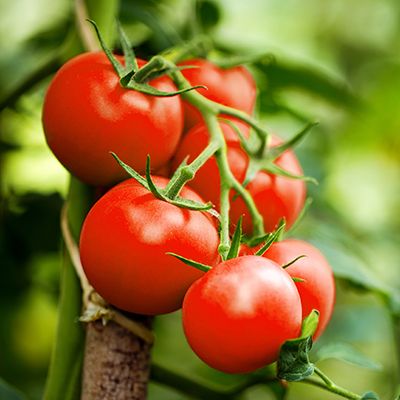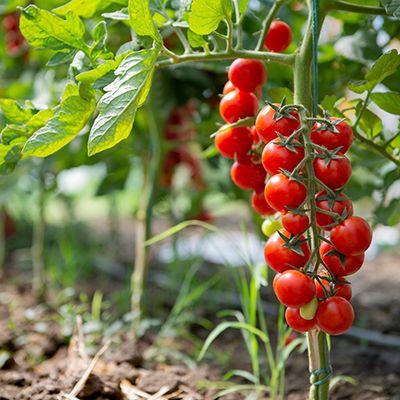


Tomatoes
Garden Grown Tomatoes taste so much better than ‘store’ tomatoes because you allow them to ripen before you pick them. Unfortunately, ripe tomatoes do not ‘ship well’ and so commercial growers pick them partially green, pack them into sealed box cars or trucks and then gas them with ethylene to turn them red. All flavor and sugar production stops when the tomatoes are picked and so you get red ethylene gassed tomatoes with little flavor.
The tomato you eat is actually a fruit, and specifically a berry, which needs all of the conditions other fruits require in order to develop its full flavor and color. In our area it is an annual but in its native South America, it is often a perennial. Tomatoes are the most commonly home grown vegetable in the United States. They grow under many different conditions and in many different forms.
Hybrid tomatoes are a cross between two different varieties of tomatoes which have the best characteristics of both parents. If you plant the seeds from a hybrid variety, (such as Ace or Early Girl), you will get a strange assortment of plants; some with the worst characteristics of both parents. Non-hybrids such as the various ‘Heritage’ tomatoes are ‘pure breds’ which will self-pollinate so the seeds can be saved and sowed from year to year and will always produce the same kind of tomato.
Determinate tomatoes reach a medium sized height and stop growing. They produce a lot of fruit on this short bush until they stop growing and then not much thereafter. Indeterminate tomatoes keep growing (and can become eight to 10 feet tall) until cold weather and the shorter days stops them. They continue to produce fruit as long as they keep growing.
Different kinds of ripe tomatoes may be any of the following colors: red, orange, yellow, green, white, black or bi-colored. Depending primarily on size, fruit will be ready to harvest in 52 to 100 days. The size of a tomato fruit ranges from a large grape (Tiny Tim) to over two pounds (Big Rainbow, 90-100 days).
Growing tomatoes is easily done if they are given reasonable care. The site should receive a minimum of eight hours of sun per day. A full day of sun is better. Raised boxes of 6 inches, 12 inches or 24 inches would be ideal with our clay soil, but planting directly in the ground works well if it is amended to a depth of six to eight inches with Master Nursery® Gold Rush or Bumper Crop. The amendment is placed two to three inches deep on the surface. Two pounds of Master Nursery® Master Start and 10 to 15 pounds of Gypsum per 100 square feet are sprinkled over the Master Nursery® Gold Rush. All three ingredients are then dug into the native soil to a depth of six to eight inches. The planting area can also be prepared by digging a hole 24 inches in diameter, 8 inches deep and mixing the soil from the hole with one-third Master Nursery® Gold Rush, one quarter cup Master Nursery® Master Start, and one cup Gypsum. Mix thoroughly and refill the hole. Tomatoes should be planted two and one-half to three feet apart. They will need some sort of support. A six foot, one by one inch stake is a minimum. Better is one of the tomato cages which are four to six feet tall.
The tomato plants are placed in the prepared soil so that two to three inches of the stem is covered. New roots will sprout along any of the stem which is underground. Water the plants thoroughly. Contrary to what you may have heard, the soil should be kept moist at all times. Any watering system except sprinklers is satisfactory, but we have found black soaker hoses to be most effective. The soakers run for four to five hours once or twice a week depending on the weather and size of the plants. Be sure the soaker hose barely drips water. If it sprays water three or more inches high, there is too much pressure and too much water is being distributed.
About one month after planting, fertilize the tomatoes with Master Nursery® Tomato and Vegetable Food or Gardner & Bloome® Tomato, Vegetable and Herb Fertilizer, if you prefer an organic formula. The fertilizers should be carefully scratched into the top inch or two of the soil and then hand watered to get them moved down into the soil. Repeat this process six weeks later.
Some people make a fetish of pinching or removing the ‘suckers’ from tomato plants. This is entirely unnecessary. Just be sure the plants are adequately supported so that the branches do not trail on the ground.
Verticillium wilt is the worst and most common (fungus) disease to affect tomatoes. The lower leaves and branches shrivel, and turn brown. The disease slowly progresses up the plant until most or all of the plant is dead. The fungus remains in the soil for five to seven years. There is no ‘medicine’ or chemical to treat the soil or plant and you should not plant tomatoes or any member of the tomato family in that area for seven years. There has been some success using sun solarization to rid the soil of Verticillium wilt fungus.
Early and late blight are also common diseases. Early blight first appears on older leaves as dark brown dead spots. These lesions expand as the disease progresses, and eventually develop black rings surrounded by a yellow chlorotic area. The lesions may join and the whole leaf turns yellow and dries up. Complete defoliation of the plant can occur. Late blight is less likely to occur in the Bay Area. Early and Late blight can be controlled by spraying with Monterey Liqui-Cop® or Bonide® Fung-onil™.
Some tomato plant labels will have the letters ‘V” or ‘F’ or ‘N’ or ‘T’ next to the name of the tomato. These letters mean that the plant is resistant (not immune) to Verticillium wilt (‘V’); or Fusarium wilt (‘F’); or Nematodes (‘N’); or Tobacco Mosaic virus (‘T’).
The two most common insect pests are white flies and tomato hornworms. The hornworms are controlled by spraying with Monterey B.t. when young or hand picking when they get big (two to three inches long). Whiteflies can be controlled by spraying with Master Nursery® Pest Fighter Year-Round Spray Oil or Monterey Take Down Garden Spray. Yellow sticky cardboard traps will cut down on the population. Aphids are a very minor problem and can usually be ignored.
Cracking, catfacing and blossom-end rot are most commonly caused by irregular watering where the soil dries out between irrigation (this is less likely with soaker hoses). Mulch the plants beyond their drip line to help prevent the soil from drying out between irrigations. Consistent moisture prevents blossom end rot and cat-facing. If the tomatoes have their own bed, fertilize, irrigate and mulch the entire area as a unit. When a plant starts fruiting, it begins looking yellow and tired. This is normal. Ease back on the water and leave them alone. Excess water will cause the fruit to be watery and tasteless.
If night temperatures drop below 55°F, any flowers on the plant will drop off and there will be no fruit on that portion of the plant. If the day time temperature goes over 90°F, any flowers on the plant will drop off and likewise no fruit. When the temperatures return to normal, the fruit production will as well. This may explain why certain sections of the plant do not produce fruit 30 to 45 days after unusual weather.
Tomatoes can be grown in containers. The minimum size is a five gallon container, but a fifteen gallon is better. Use a top grade potting soil such as Master Nursery® Gardener’s Gold and plant as outlined above. Fertilize one month after planting and each month, thereafter with Master Nursery® Tomato and Vegetable Food or Gardner & Bloome® Tomato, Vegetable and Herb Fertilizer. Water as needed and until water runs out the bottom of the container. A cherry tomato or medium sized tomato (Early Girl, First Lady, Better Boy) supported by a wire cage is recommended.
Wegman’s Expert Tip: Put the yellow sticky cardboard traps out as soon as you plant your tomatoes.